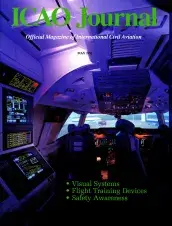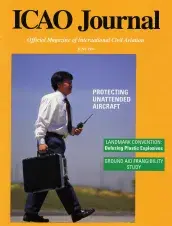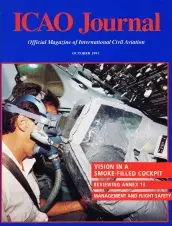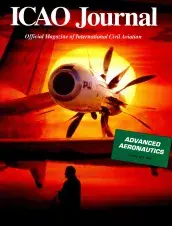国际民航组织期刊
The objective of the Journal is to provide a concise account of the activities of the International Civil Aviation Organization and to feature additional information of interest to Contracting States and the international aeronautical world.
 (ICAO Journal is available in English only from 2013)
(ICAO Journal is available in English only from 2013)
Because of the great advances in computer technology in recent years, flight simulator visual systems have steadily improved and yet they have continued to be affordable. New features such as photo-texture hi-linear blending and enhanced system capacity are found in the advanced equipment being produced by Rediffusion Simulation in the United Kingdom. Shown is a view of a new MD-11 flight simulator employing the firm's SP-X 500 visual system.
A portable self-contained intrusion detection system can be hand-carried and quickly activated to protect sensitive areas. Shown in its transportable state is the Sentrie intrusion detection system manufactured by EG&G Astrophysics Research. An article on the subject of security for parked, unattended aircraft begins on page 13.
A McDonnell Douglas MD-80 nose section takes shape at the Douglas Aircraft assembly facility. The world's airlines ordered 895 twin-engined jet transports in 1990, with Douglas accounting for 116 of the orders. The U.S. aircraft builder delivered 139 MD-80/90s in 1990. For more information on the grooving air carrier fleet, see page 14.
The Swearingen SJ30 business jet had accumulated approximately 100 hours in its flight test programme by the end of July and had even made its debut at the Paris Air Show, where the aeroplane participated in daily flight demonstrations. The six-passenger aircraft, powered by the Williams International FJ44 engine of 8.44-kN take-off thrust, incorporates the swept wing and high-performance lift devices common in commercial transports.
A student controller practises her skills at a radar simulator at Dundridge College in the United Kingdom. The private ATC training centre is currently involved in a programme to prepare ex-military controllers to the U.K. civil rating standard in aerodrome, approach, and approach radar control. Established in 1984, the college emphasizes development of training aids to enhance the learning process.
A safety device has been developed to prevent loss of pilot vision in the event the cockpit is filled with smoke. Recently certificated by the U.S. Federal Aviation Administration for use in some air transports, the emergency vision assurance system is based on a simple principle: instead of evacuating smoke, the device positively displaces all smoke from the vision path. By peering through the inflated envelope, the pilot is able to see the primary flight instruments and outside the windshield.
Several articles this month explore the significance and impact of the future air navigation system (FANS) concept from a number of different perspectives. As noted in the introduction on page 6, difficult decisions must be made and the transition to the new system will require coordination on an unprecedented scale throughout the aviation industry.
At Memphis (Tennessee) International Airport, a conventional Mode-S secondary surveillance radar system is employed as a demonstrator "precision runway monitor (PRM)" using back-to-back antennas. Thus, the data update occurs every 2.4 seconds instead of 4.8 seconds. Developed by MIT's Lincoln Laboratory, this particular system has been in test operation since late 1988 and is in competition with a similar system using a circular phased-array antenna and advanced processing
This automated Flight Data Processing System workstation shows display techniques intended for oceanic air traffic control applications. Prompt traffic controller-system interaction and ATC functionality result in significantly increased operations efficiency and higher flight safety. For details on one specific application of such a system, see story beginning on page 9 herein.
A family of phased-array three-dimensional wind profilers has been developed by REMTECH (U.S.A.). These are electronically steered beam, phased-array antenna sodars which provide a significant increase in range — to 20 kilometres. The PA4 antenna shown, with an average range of 3 kin, was first demonstrated in late 1988 at the Boulder Atmospheric Observatory in Colorado, a U.S. National Oceanic and Atmospheric Administration facility.











